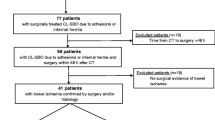Abstract
Purpose
To determine the differential points of strangulated ileus with and without irreversible ischaemic changes, especially on preoperative computed tomography (CT) images.
Methods
Seventy patients with strangulated ileus underwent emergency operations between January 2009 and July 2016 in our department. Of these patients, 57 met the study requirements, including 30 patients who had irreversible ischaemic changes (ischaemic group; n = 30) and 27 patients who had reversible ischaemic changes during laparotomy (non-ischaemic group; n = 27). We compared the preoperative clinical and radiographic factors between the ischaemic and non-ischaemic groups.
Results
Univariate analysis revealed that a mean CT value of the intestine in an unenhanced image ≥16.5 HU (p < 0.001), a mean CT value ratio of the intestine (enhanced/unenhanced image) <1.5 (p < 0.001), presence of mesenteric fluid (p = 0.002) and presence of free peritoneal fluid (p = 0.009) were associated with the ischaemic group.
Conclusions
Calculation of the mean CT value of a strangulated intestine may be a useful method for predicting irreversible ischaemic changes in addition to the presence of mesenteric fluid or free peritoneal fluid.


Similar content being viewed by others
References
Maglinte DD, Howard TJ, Lillemoe KD, Sandrasegaran K, Rex DK (2008) Small-bowel obstruction: state-of-the-art imaging and its role in clinical management. Clin Gastroenterol Hepatol 6:130–139
Wiesner W, Khurana B, Ji H, Ros PR (2003) CT of acute bowel. Radiology 226:635–650
Takahashi R, Akagi Y, Tanaka T, et al. (2014) Clinicopathological evaluation of anoxic mucosal injury in strangulation ileus. BMC Surg 14:79
O’Connor DB, Winter DC (2012) The role of laparoscopy in the management of acute small-bowel obstruction: a review of over 2,000 cases. Surg Endosc 26:12–17
Dindo D, Demartines N, Clavien PA (2004) Classification of surgical complications: a new proposal with evaluation in a cohort of 6336 patients and results of a survey. Ann Surg 240:205–213
Millet I, Taourel P, Ruyer A, Molinari N (2015) Value of CT findings to predict surgical ischemia in small bowel obstruction: a systematic review and meta-analysis. Eur Radiol 25:1823–1835
Hayakawa K, Tanikake M, Yoshida S, et al. (2013) CT findings of small bowel strangulation: the importance of contrast enhancement. Emerg Radiol 20:3–9
Sheedy SP, Earnest F IV, Fletcher JG, Fidler JL, Hoskin TL (2006) CT of small-bowel ischemia associated with obstruction in emergency department patients: diagnostic performance evaluation. Radiology 241:729–736
Wiesner W, Mortele K (2011) Small bowel ischemia caused by strangulation in complicated small bowel obstruction. CT findings in 20 cases with histopathological correlation. JBR-BTR 94:309–314
Geffroy Y, Boulay-Coletta I, Jullès MC, et al. (2014) Increased unenhanced bowel-wall attenuation at multidetector CT is highly specific of ischemia complicating small-bowel obstruction. Radiology 270:159–167
Miyaki Y, Yamaguchi A, Isogai M, et al. (2008) Utility of CT value measurement of fluid accumulated in expanded intestinal lumen in the diagnosis of strangulated small bowel obstruction. Jpn J Gastroenterol Surg 41:464–468 (in Japanese)
Yamamoto Y, Türkoğlu MA, Aramaki T, et al. (2016) Vascularity of intrahepatic cholangiocarcinoma on computed tomography is predictive of lymph node metastasis. Ann Surg Oncol 23:485–493
Maehira H, Itoh A, Kawasaki M, et al. (2016) Use of dynamic computed tomography attenuation value for diagnosis of acute gangrenous cholecystitis. Am J Emerg Med. doi:10.1016/j.ajem.2016.08.033
Jiang B, Wang J, Jia P, Le M (2013) The value of CT attenuation in distinguishing atypical adenomatous hyperplasia from adenocarcinoma in situ. Zhongguo Fei Ai Za Zhi 16:579–583
Edwards RM, Godwin JD, Hippe DS, Kicska G (2016) A quantitative approach to distinguish pneumonia from atelectasis using computed tomography attenuation. J Comput Assist Tomogr 40:746–751
Author information
Authors and Affiliations
Corresponding author
Ethics declarations
Funding
This research did not receive any specific grant from funding agencies in the public, commercial, or not-for-profit sectors.
Conflict of interest
The authors declare that they have no conflict of interest. The authors have no direct or indirect commercial or financial incentives associated with publishing this article.
Ethical approval
All procedures performed in studies involving human participants were in accordance with the ethical standards of the Institutional and/or National Research Committee and with the 1964 Helsinki Declaration and its later amendments or comparable ethical standards. For this type of study formal consent is not required. The study protocol was approved by the Institutional Review Board. The study does not include any animal experiments.
Informed consent
This article does not contain any studies with human participants or animals performed by any of the authors.
Additional information
This retrospective study is for academic communication only and is not for other purposes.
Rights and permissions
About this article
Cite this article
Kohga, A., Kawabe, A., Yajima, K. et al. CT value of the intestine is useful predictor for differentiate irreversible ischaemic changes in strangulated ileus. Abdom Radiol 42, 2816–2821 (2017). https://doi.org/10.1007/s00261-017-1227-z
Published:
Issue Date:
DOI: https://doi.org/10.1007/s00261-017-1227-z




